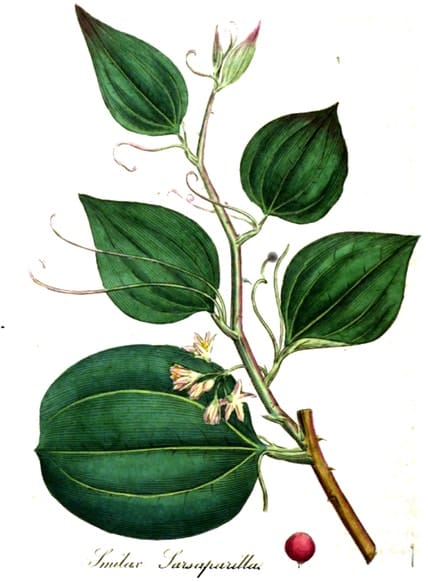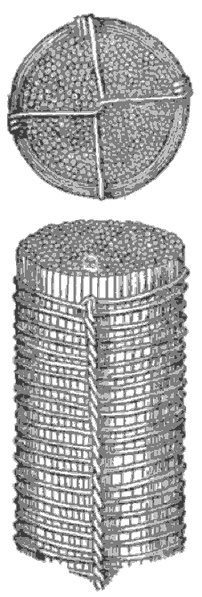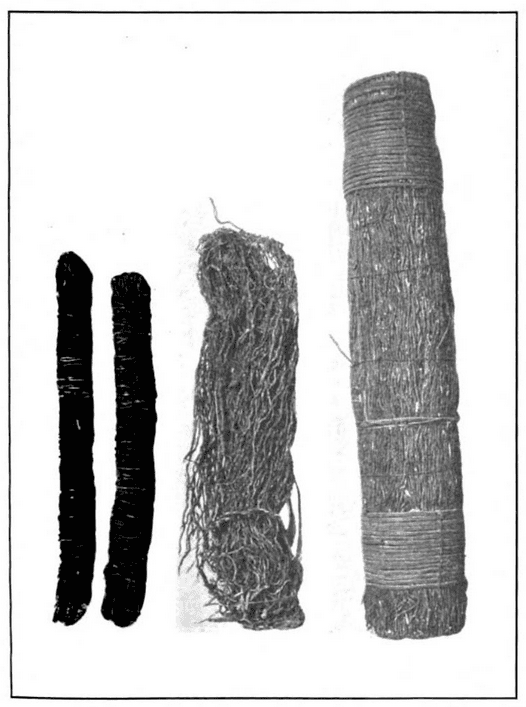SarsaparillaUshba (Unani) |

|
 Medical Botany, Woodville, 1810
Medical Botany, Woodville, 1810

|

|

|
Notes on Pharmacognosy, Otto Augustus Wall, 1902
 Bundles of Sarsaparilla as imported; the 2 on the left from Honduras;
Bundles of Sarsaparilla as imported; the 2 on the left from Honduras;the middle from Mexico; the large on the right from Brazillian (Para).
A Manual of Organic Materia Medica and Pharmacognosy, Sayre, 1907
Botanical name:
Smilax spp.
Several varieties are known on the market:
- Brazilian, Rio, Rio Negro, Para, Lisbon or Portuguese Sarsaparilla–S. officinalis, S. japicanga; long, thin roots, reddish or blackish-brown, white internally with a bitter taste. Accounted best.
- Honduras Sarsaparilla–S. officinalis, S. regelii; dull brown bark, pinkish internally
- Red or Jamaica Sarsaparilla–S. regelii, S. ornata; orange-red, reddish-grey or whitish colored; bitter, stronger and more aromatic than the others
- Mexican Sarsaparilla–S. aristolochiaefolia, S. ornata, S. sarsaparilla (syn. S. glauca)
- Ecuadorian sarsaparilla–S. febrifuga
Parts used:
Root
Temperature & Taste:
Neutral. Sweet.
Classifications:
2F. PURIFYING
3A. SUDORIFICS & DIAPHORETICS. 3M. ARTHRITICS
Uses:
1. Clears Heat, Damp and Toxin, Promotes Urine:
-Joint Pain including Rheumatism and Rheumatoid Arthritis;
-hot, painful Urination, or Jaundice, especially when present with both heat and damp symptoms.
-conditions such as Scrofula, Lymphadenitis, Tumors when presenting with appropriate symptoms.
-‘A remedy against long continual pain of the Joints and Head’ (Gerard)
–Catarrh and all types of Defluxion
–Alexipharmic: an Antidote to various Poisons.
2. Clears Heat, Damp and Toxin from the Skin:
-recurrent Ulcers, Venereal Disease (especially Syphilis), Thrush, and other skin diseases or lesions from toxic heat, or heat and dampness.
-Internally and externally it is used for such conditions as Eczema and Psoriasis.
3. Strengthens the Kidneys:
-Native American healers have used Sarsaparilla for Impotence and Sexual Debility.
4. Settles Wind:
-It has also been used for Hypertension.
Dose:
Powder: 2–6 grams;
Decoction: 6–15 grams (very large doses having been used in Syphilis, Cancer, Rheumatism etc).
In the treatment of Syphilis, it was reported that the Indian physicians require patients to fast for 3 days while drinking only a decoction of Sarsaparilla. (A Treatise on Foreign Drugs, Geoffroy and Thicknesse, 1749)
Comment:
Traditionally much used in ‘Diet Drinks’, cleansing drinks taken in the treatment of various chronic conditions. Often combined with Guaiacum, Sassafras and other alteratives, a decoction being taken throughout the day as common drink. Used like this in chronic and obstinate diseases such as joint disease, chronic skin complaints, Fibroid Tumors and Cancer.
Main Combinations:
Guaiacum & Sarsaparilla
1. Rheumatic pains, Ulcers, Skin disease:
i. Sarsaparilla with China root, Sandalwood, Deer horn (as in Decoction to Sweeten)
ii. Sarsaparilla with Sassafras root, Guaiacum wood, Mezereon root, Licorice (as in Decoction of Sarsaparilla)
2. Syphilis, Edema and Arthritic complaints, Sarsaparilla with China root, Guaiacum Wood, Sassafras, Sandalwood, Coriander seed, Licorice (as in Water of Sarsaparilla)
3. Syphilis:
i. Sarsaparilla with Mezereon bark
ii. Sarsaparilla with China root, Torrified Hazelnuts (4 oz. each), Cloves (5 oz.), Honey sufficient to form an Electuary. Used for Syphilis, Syphilitic Ulcers of the Throat, and chronic or degenerated Syphilis. (Memorial Pharmaceutique, 1824)
iii. Decoction of Sarsaparilla with Potassium nitrate and Spirit of Camphor.
iv. Sarsaparilla with Guiaiacum, Potassium subcarbonate, Senna, Sassafras, Licorice, Rhubarb, Coriander. (Pharmacopoeia Gallica, 1818)
v. Sarsaparilla with China root, Sassafras, Polypody, Rhubarb, Licorice, Senna, Coriander seed (Pharmacopoeia Generalis, 1783)
vi. Sarsaparilla (6 oz.), Senna (3 oz.), Guaiacum, Sassafras, Orris, Sulphuret of Antimony, Aniseed, Cream of Tartar, Long Birthwort, Round Birthwort, Jalap, Polypody (1 ½ oz. each), fresh Walnuts with rind, bruised (12), White Wine (3 lbs.). Infuse 24 hours in hot ashes, then add Spring Water (6 lbs.). Evaporate slowly to two-thirds, then strain through flannel. Dose: 3 glassfuls daily. It can also be made into a thick syrup with an equal weight of Sugar, a spoonful being given 4 times per day. (Memorial Pharmaceutique, 1824)
4. To clear Heat and Toxin from the Blood:
i. Sarsaparilla with Burdock root, Bittersweet, Guaiacum, Licorice (Schönmehl)
ii. Sarsaparilla with Mezereon root, Guaiacum, Yellow Dock, Burdock, Bittersweet, Elm Bark, Elder Flowers, Fumitory, Wood Sanicle (Model Botanic Guide to Health)
iii. Boils, Sarsaparilla with Burdock root
5. Skin and Joint diseases:
i. Sarsaparilla with Guaiacum, Sassafras, Restharrow (German Pharmacopoeia)
ii. Sarsaparilla with Guaiacum, Sassafras, Sarsaparilla, China root (as in Decoction of Woods)
iii. Sarsaparilla with Dodder, Senna, China root, Fennel seed, Polypody, Sandalwood, Valerian, Cinnamon, Fumitory and Triphala (as in Electuary of Sarsaparilla of Unani)
6. Psoriasis:
i. Sarsaparilla with Thuja
ii. Sarsaparilla with Fumitory, Senna
iii. Sarsaparilla with Figwort, Burdock seed, Rhubarb, Licorice
iv. Sarsaparilla with Poke root, Thuja
7. Scrofula:
i. Sarsaparilla with Figwort
ii. Sarsaparilla with Fumitory, Woody Nightshade, Burdock
8. Arthritis, Rheumatism:
i. decoct Sarsaparilla with a Chicken (A Treatise on Foreign Drugs, Geoffroy and Thicknesse, 1749)
ii. Sarsaparilla, Centaury, Round Birthwort root (1 ½ oz. each), Germander, Ground Pine, St. Johns wort seed (2 oz. each), Angelica (½ oz.), Cinnamon (½ dram), Saffron (1 scruple), Clove (½ scruple). Powder, mix with three times their weight of Honey. Dose: 1½ drams every morning for a year. (A Treatise on Foreign Drugs, Geoffroy and Thicknesse, 1749)
iii. Sarsaparilla with St. Johns Wort, Germander, Ground Pine, Angelica, Betony, Cloves, burnt Deer horn, Amber, Coral (as in Arthritic Electuary of Platerus)
iv. Sarsaparilla with Guaiacum, Mistletoe, Germander, Ground Ivy, Sage, Primula, Rosemary, St Johns wort (as in Wine for Arthritis)
9. Diaphoretic and Diuretic, Sarsaparilla with Sassafras and Butchers Broom (equal parts) (Memorial Pharmaceutique, 1824)
10. Diaphoretic, Sudorific:
i. Sarsaparilla with China root, Bittersweet, (Memorial Pharmaceutique, 1824)
ii. Sarsaparilla with Bittersweet, Soapwort root (Nouveau Formulaire Medicale et Pharmaceutique, 1820)
iii. Sarsaparilla with Guaiacum wood, Bittersweet, Fennel (Picettario Clinico, Padua, 1825)
Major Formula:
Decoction of Guaiacum and Sarsaparilla
Decoction of Sarsaparilla Against Apoplexy
Decoction for Skin Disease
Decoction Liberans
Decoction of Woods
Decoction to Sweeten
Sudorific Vinegar
Electuary for Arthritis
Cautions:
Generally Safe and well tolerated.
Main Preparations used:
-
Extra Info
- History
|
‘Monardes has recorded that sarsaparilla was first introduced to Seville about the year 1536 or 1545, from New Spain; and a better variety soon afterwards from Honduras. He further narrates that a drug of excellent quality was subsequently imported from the province of Quito, that it was collected in the neighbourhood of Guayaquil, and was of a dark hue, and larger and thicker than that of Honduras. Pedro de Ciezo de Leon, in his Chronicle of Peru, which contains the observations made by him in South America between 1532 and 1550, gives a particular account of the sarsaparilla which grows in the province of Guayaquil and the adjacent island of Puna, and recommends the sudorific treatment of syphilis, exactly as pursued at the present time. These statements are confirmed by the testimony of other writers. Thus, Joao Rodriguez de Castello Branco, commonly known as Amatus Lusitanus, a Portuguese physician of Jewish origin, who practised chiefly in Italy, has left a work recording his medical experiences and narrating cases of successful treatment. One of the latter concerns a patient |
suffering from acute rheumatism, for whom he finally prescribed Sarsaparilla. This drug, he explains, has of late years been brought from the newly found country of Peru, that it is in long whip-like roots, growing from the stock of a sort of bramble resembling a vine, that the Spaniards call it Zarza parrilla, and that it is an excellent medicine. About the same period, sarsaparilla was described by Auger Ferrier, a physician of Toulouse, who states that in the treatment of syphilis, which he calls Lues Hispanica, it is believed to be better than either China root or Lignum sanctum. Girolamo Cardano of Milan, in a little work called Deradice Cina et Sarza Parilia judicium, expresses similar opinions. After so strong recommendations, the drug soon found its way to the pharmaceutical stores; we find it quoted for instance in 1563, in the tariff of the “Apotheke” of the little town of Annaberg in Saxony. We have also noticed “Sarsaparilla” in the Ricettario Florentine-of the year 1573. Gerarde, who wrote about the close of the century, states that the sarsaparilla of Peru is imported into England in abundance.’ (Pharmacographia, Fluckiger & Hanbury, 1879) |
